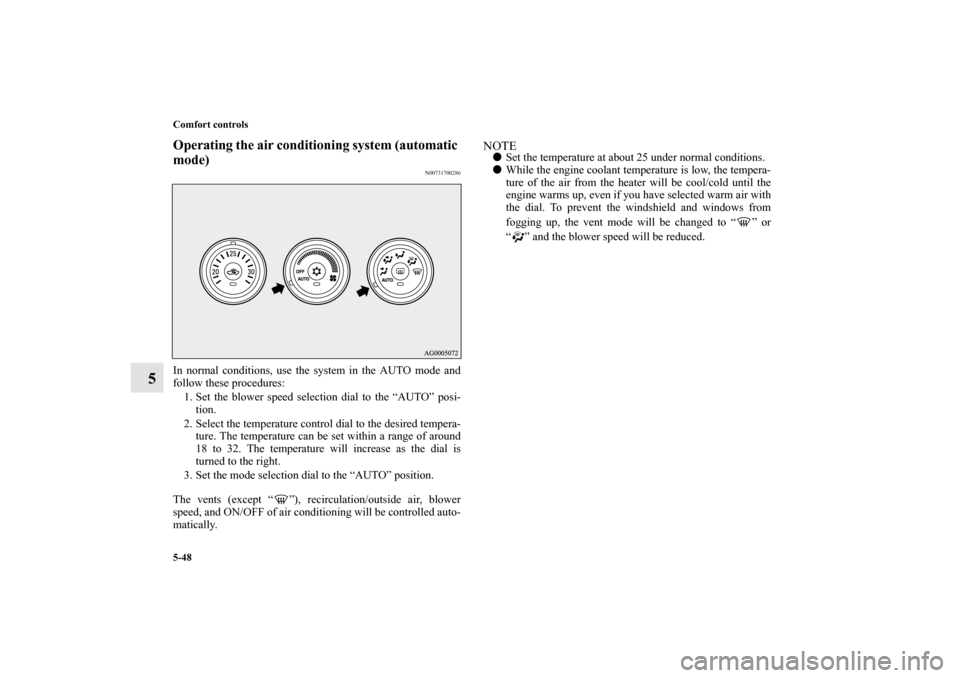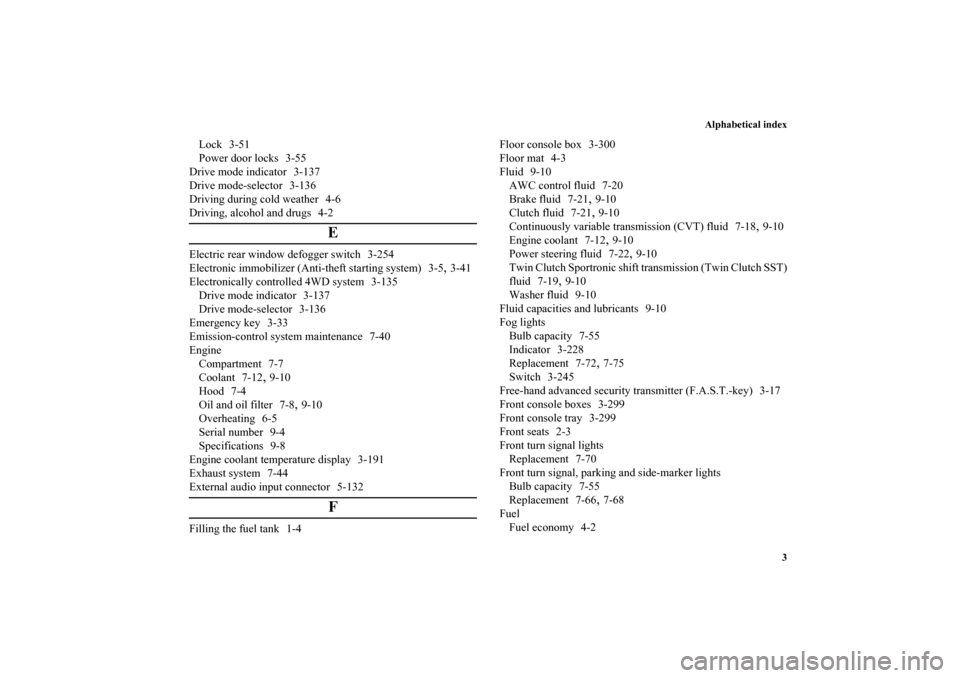Page 465 of 722

5-48 Comfort controls
5
Operating the air conditioning system (automatic
mode)
N00731700286
In normal conditions, use the system in the AUTO mode and
follow these procedures:
1. Set the blower speed selection dial to the “AUTO” posi-
tion.
2. Select the temperature control dial to the desired tempera-
ture. The temperature can be set within a range of around
18 to 32. The temperature will increase as the dial is
turned to the right.
3. Set the mode selection dial to the “AUTO” position.
The vents (except “ ”), recirculation/outside air, blower
speed, and ON/OFF of air conditioning will be controlled auto-
matically.
NOTE�Set the temperature at about 25 under normal conditions.
�While the engine coolant temperature is low, the tempera-
ture of the air from the heater will be cool/cold until the
engine warms up, even if you have selected warm air with
the dial. To prevent the windshield and windows from
fogging up, the vent mode will be changed to “ ” or
“ ” and the blower speed will be reduced.
BK0138600US.book 48 ページ 2011年7月17日 日曜日 午後2時32分
Page 576 of 722

For emergencies
6-5
6
As your vehicle has anti-lock brakesIf you drive your vehicle with a low battery charge, after the
engine has been started by using jumper cables, the engine may
misfire. This can cause the anti-lock braking system warning
light to blink on and off. This is only due to the low battery
voltage. It is not a problem with the brake system. If this hap-
pens, fully charge the battery and ensure the charging system is
operating properly.
Engine overheating
N00836500323
When the engine has overheated, the information screen in the
multi-information display will be interrupted and the engine
coolant temperature warning display will appear. The screen
will then change to the engine coolant temperature display
screen and “ ” will flash. If this happens:
1. Stop the vehicle in a safe place. Turn on the hazard warn-
ing flashers.
2. With the engine still running, carefully raise the engine
hood to vent the engine compartment.
3. Check that the cooling fan is running. If the fan is not
turning, stop the engine immediately and contact an
authorized Mitsubishi Motors dealer or a repair facility of
your choice for assistance.
4. If you see steam or spray coming from under the hood,
turn off the engine.
WA R N I N G
!�To avoid personal injury, keep hands, hair, jewelry
and clothes away from the cooling fan. The cooling
fan can start at any time.
BK0138600US.book 5 ページ 2011年7月17日 日曜日 午後2時32分
Page 577 of 722

6-6 For emergencies
6
5. If you do not see steam or spray coming from under the
hood, leave the engine on until the bar graph for the
engine coolant temperature warning display on the multi-
information display goes down. When it is in the middle
of the normal zone, you can start driving again. If the bar
graph stays in the red zone, turn off the engine.
6. When you do not see any more steam or spray, open the
hood. Look for obvious leaks, such as a split radiator
hose. Be careful as components will be hot. Any leak
source must be repaired.
7. If there is no obvious leak source, check the coolant level
in the reserve tank. If there is none, or if it is too low,
slowly add coolant.8. If the reserve tank needs coolant, you will probably also
need to add coolant to the radiator. Do not loosen or
remove the radiator cap until the engine has cooled down.
9. Start the engine, and slowly add coolant, up to the bottom
of the filler neck. Use plain water if you have to (and
replace it with the right coolant as soon as possible).
10. Replace the radiator cap and tighten it fully. Check the
engine coolant temperature display on the multi-informa-
tion display. You can start driving again when the bar
graph for the engine coolant temperature display returns
to the normal zone.
11. Have your vehicle checked by your authorized Mitsubishi
Motors dealer or a repair facility of your choice.
WA R N I N G
!�Before raising the engine hood, check to see if there
is steam or spray coming from under the hood.
Steam or spray coming from an overheated engine
could seriously scald you.
Do not open the hood until there is no steam or
spray.
WA R N I N G
!�Removing the radiator cap could scald you with
escaping hot water or steam. When checking the
radiator level, cover the cap with a cloth before try-
ing to remove it. Turn it slowly counterclockwise,
without pressing down, to the first notch. The pres-
sure in the system will then be let out. When the
pressure is COMPLETELY LET OUT, press down
and keep turning the cap counterclockwise until it
will come off.
BK0138600US.book 6 ページ 2011年7月17日 日曜日 午後2時32分
Page 610 of 722

Vehicle care and maintenance
7-13
7
To add coolant Mitsubishi Genuine Coolant provides excellent protection
against corrosion and rust formation on all metals, including
aluminum, and prevents blockages in some parts of engine.
If you need to add coolant often, or if the level in the reserve
tank does not drop when the engine cools, the cooling system
should be pressure-tested for leaks. Take your vehicle to an
authorized Mitsubishi Motors dealer or a repair facility of your
choice for testing.
*- Front of the vehicleExcept for vehicles with turbocharger
FULL
LOWVehicles with turbocharger
FULL
LOW
Use “Dia Queen Super Long Life Coolant Premium” or an
equivalent*.
* : similar high quality ethylene glycol based non-silicate, non-
amine, non-nitrate and non-borate coolant with long life
hybrid organic acid technology
CAUTION
!�Do not use alcohol or methanol antifreeze or any
engine coolants that contain them. Using the wrong
antifreeze can corrode aluminum parts. �The required concentration of anti-freeze differs
depending on the expected ambient temperature.
Above -31 °F (-35 °C) : 50 % concentration of anti-
freeze
Below -31 °F (-35 °C) : 60 % concentration of anti-
freeze
You can check the concentration level with a gauge
from an automotive supply store, or your authorized
Mitsubishi Motors dealer or service station can
check it for you.
BK0138600US.book 13 ページ 2011年7月17日 日曜日 午後2時32分
Page 611 of 722

7-14 Vehicle care and maintenance
7
Radiator capThe radiator cap must be tight sealed to prevent losing coolant
which may result in engine damage. Only use a Genuine
Mitsubishi Parts radiator cap, or an approved equivalent.Points to remember �Do not overfill the reserve tank.
�Your vehicle uses a special radiator cap that stays sealed
and lets the coolant flow from the reserve tank back to the
radiator when the engine cools down. If you need to
change the cap, use the exact same kind.
�Check the coolant freeze point in the radiator with the
proper gauge, and only when it is safe. If you add anti-
freeze, the contents of the reserve tank must be protected
against freezing.
�Keep the front of the radiator and condenser clean. �If the temperature of the engine coolant does not rise after
the engine is warmed-up, take your vehicle to an autho-
rized Mitsubishi Motors dealer or a repair facility of your
choice to have the thermostat checked, and replaced if
necessary.�Do not use water to adjust the concentration of cool-
ant. �Do not top off the tank with plain water only. Water
by itself boils at a lower temperature and does not
stop rust or freezing. If the water freezes, it will
damage your cooling system. Do not use tapwater. It
can cause corrosion and rust.
WA R N I N G
!�Wait for the engine to cool down before opening the
radiator cap. Otherwise hot steam or boiling coolant
could spray up from the radiator and scald you.
CAUTION
!
BK0138600US.book 14 ページ 2011年7月17日 日曜日 午後2時32分
Page 714 of 722

Alphabetical index
3
Lock 3-51
Power door locks 3-55
Drive mode indicator 3-137
Drive mode-selector 3-136
Driving during cold weather 4-6
Driving, alcohol and drugs 4-2
E
Electric rear window defogger switch 3-254
Electronic immobilizer (Anti-theft starting system) 3-5
,3-41
Electronically controlled 4WD system 3-135
Drive mode indicator 3-137
Drive mode-selector 3-136
Emergency key 3-33
Emission-control system maintenance 7-40
Engine
Compartment 7-7
Coolant 7-12
,9-10
Hood 7-4
Oil and oil filter 7-8
,9-10
Overheating 6-5
Serial number 9-4
Specifications 9-8
Engine coolant temperature display 3-191
Exhaust system 7-44
External audio input connector 5-132
F
Filling the fuel tank 1-4Floor console box 3-300
Floor mat 4-3
Fluid 9-10
AWC control fluid 7-20
Brake fluid 7-21
,9-10
Clutch fluid 7-21,9-10
Continuously variable transmission (CVT) fluid 7-18
,9-10
Engine coolant 7-12
,9-10
Power steering fluid 7-22
,9-10
Twin Clutch Sportronic shift transmission (Twin Clutch SST)
fluid 7-19
,9-10
Washer fluid 9-10
Fluid capacities and lubricants 9-10
Fog lights
Bulb capacity 7-55
Indicator 3-228
Replacement 7-72
,7-75
Switch 3-245
Free-hand advanced security transmitter (F.A.S.T.-key) 3-17
Front console boxes 3-299
Front console tray 3-299
Front seats 2-3
Front turn signal lights
Replacement 7-70
Front turn signal, parking and side-marker lights
Bulb capacity 7-55
Replacement 7-66,7-68
Fuel
Fuel economy 4-2
BK0138600US.book 3 ページ 2011年7月17日 日曜日 午後2時32分
Page:
< prev 1-8 9-16 17-24